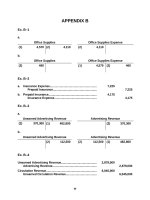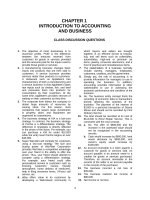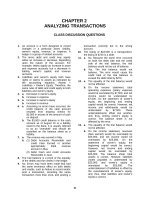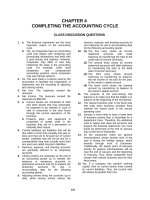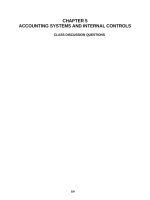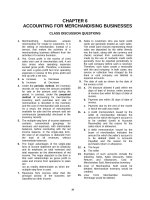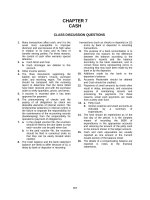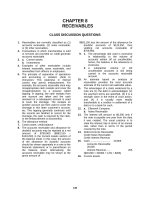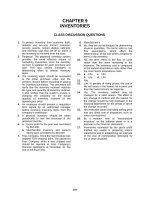Solution manual investments 10th by jones ch21
Bạn đang xem bản rút gọn của tài liệu. Xem và tải ngay bản đầy đủ của tài liệu tại đây (84.82 KB, 18 trang )
PART EIGHT: INVESTMENT MANAGEMENT
Chapter 21:
Portfolio Management
CHAPTER OVERVIEW
Chapter 21 covers some portfolio management topics primarily
having to do with actual investment practice. The emphasis in
Chapter 21 is on the more practical, day-to-day aspects of
portfolio management whereas Chapters 19 and 20 cover the
theoretical aspects of portfolio management.
Chapter 21 is designed to integrate very closely with AIMR’s
approach to portfolio management, which emphasizes that it is a
process to be followed by all firms and managers. While the
details will vary from manager to manager, the process will be
the same.
Chapter 21 begins by explaining portfolio management as a
process, integrating a set of activities in a logical and orderly
manner. The process is systematic, continuous, dynamic, and
flexible. It encompasses all portfolio investments. Having
structured portfolio management as a process, any portfolio
manager can execute the necessary decisions for an investor.
Figure 21-1 outlines the process as described by Maginn and
Tuttle in Managing Investment Portfolios, an AIMR book on the
subject. These steps are described in more detail in the
chapter.
Individual investors are contrasted with institutional
investors. Instructors may wish to add their own detail in this
area. Covered here are such concepts as the life cycle.
The remainder of the chapter focuses on the steps in the
investment process. The first step, the determination of
portfolio policies, receives the most emphasis because this is
the part of the process involving objectives, constraints, and
preferences, and this material receives the bulk of the attention
in the CFA program.
45
The other steps in the process are discussed, and details
are added where appropriate. For example, in the discussion of
forming expectations, the author's work on probabilities
associated with common stock returns is included. This material
allows students to see the risk involved with common stocks, and
can be a good focal point for class discussion.
Other important topics are discussed in this chapter. These
include the important topic of asset allocation, including the
types of asset allocation. Other topics are also touched upon,
such as portfolio optimization and the costs of trading.
CHAPTER OBJECTIVES
To discuss why portfolio management should be thought of,
and implemented as, a process.
To describe the steps involved in the portfolio management
process.
To assess related issues of importance, such as asset
allocation.
46
MAJOR CHAPTER HEADINGS [Contents]
Portfolio Management as a Process
[description of the process and what is involved; outline of
the steps; figure showing the process]
Individual Investors vs. Institutional Investors
[a summary of the differences between the two;
characteristics of investment policies for each]
Formulate an Appropriate Investment Policy
[overall view]
Objectives
[discussion of life cycle for individual investors;
inflation considerations]
Constraints and Preferences
[time; liquidity; taxes; regulatory; unique needs; example
of stating all of these factors for two different investors]
Develop Investment Strategies
[Forming Expectations--macro and micro; rate of return
assumptions--importance of historical data; arithmetic and
geometric means; probabilities associated with common stock
returns]
Constructing the Portfolio
[steps in the process]
Asset Allocation
[importance; making the decision; example; types of asset
allocation]
Portfolio Optimization
[the Markowitz model]
Monitor Market Conditions and Investor Circumstances
47
Monitoring Market Conditions
Changes in Investor Circumstances
Make Portfolio Adjustments As Necessary
[the costs of trading]
Performance Measurement
[introduction to Chapter 22, which covers the evaluation of
portfolio performance]
POINTS TO NOTE ABOUT CHAPTER 21
Tables and Figures
Figure 21-1 is a diagram, from Maginn and Tuttle, of the
portfolio management process.
Figure 21-2 illustrates risk/return positions at various
life cycle stages.
Table 21-1 contains the probabilities associated with common
stock returns as calculated and reported in The Journal of
Portfolio Management. This is a very detailed table of
probabilities and can be used to show the risk of common stocks.
Table 21-2, taken from AAII Journal, illustrates some asset
allocation possibilities depending upon stage in the life cycle
and risk posture assumed.
Box Inserts
There are no box inserts for Chapter 21.
48
ANSWERS TO END-OF-CHAPTER QUESTIONS
21-1.
Portfolio management is best thought of as a
process, meaning that it can applied in any
situation to any manager. As a process, it is
continuous, systematic, dynamic and flexible, and it
applies to all investments.
21-2.
NO! The process should be used by all managers, but
the details can vary. Therefore, firms can be
organized differently.
21-3.
A major difference between the two occurs with
regard to time horizon because institutional
investors are often thought of on a perpetual basis,
but this concept has no meaning when applied to
individual investors. As explained below, for
individual investors it is often useful to think of
a life cycle approach, as people go from the
beginning of their careers to retirement. This
approach is less useful for institutional investors
because they typically maintain a relatively
constant profile across time.
Kaiser has summarized the differences between
individual investors and institutional investors as
follows:1
1.
Individuals define risk as “losing money”
while institutionals use a quantitative
approach, typically defining risk in
terms of standard deviation (as in the
case of the Ibbotson data presented in
Chapter 6).
2.
Individuals can be characterized by their
personalities, while for institutions we
consider the investment characteristics
of those with a beneficial interest in
the portfolios managed by the
institutions.
1 See Ronald W. Kaiser, “Individual Investors,” in Managing Investment Portfolios, 2nd. ed., John
L. Maginn, CFA and Donald L. Tuttle, CFA, eds. (Charlottesville, Va.: Association for Investment
Management and Research, 1990), p. 3-2.
3.
Goals are a key part of what individual
investing is all about, along with their
assets, while for institutions we can be
more
precise as to their total package of
assets and liabilities.
4.
Individuals have great freedom in what
they can do with regard to investing,
while institutions are subject to
numerous legal and regulatory
constraints.
5.
Taxes often are a very important
consideration for individual investors,
whereas many institutions, such as
pension funds, are free of such
considerations.
21-4.
The investment policy is the first step in the
portfolio management process. It consists of
objectives, constraints, and preferences, and sets
the stage for the entire process. The investment
policy describes what the investor is trying to
achieve in terms of return and risk, and the
investor's constraints and preferences.
21-5.
The investment policy statement spells out the
investor's objectives, constraints and preferences,
thereby making operational a statement for
investment managers to follow. For example, if,
under constraints, it is stated that the investor is
in the highest tax bracket and wishes to hold some
bonds, the manager may be guided very quickly to
municipals.
21.6.
The asset allocation decision, having been made,
has the greatest impact on the portfolio. For
example, if it is decided to allocate 90 percent of
the portfolio to stocks, a strong upward stock
market, or a strong downward market, will clearly
have a very large impact on the performance of the
portfolio.
21-7.
1.
Strategic asset allocation This type of
allocation is usually done once every few
years, using simulation procedures to
determine the likely range of outcomes
associated with each mix. The investor
considers the range of outcomes for each mix,
and chooses the preferred one, thereby
establishing a long-run, or strategic asset
mix.
2.
21-8.
Tactical asset allocation This type of
allocation is performed routinely, as part of
the ongoing process of asset management.
Changes in asset mixes are driven by changes
in predictions concerning asset returns. As
predictions of the expected returns on stocks,
bonds and other assets change, the percentages
of these assets held in the portfolio changes.
In effect, tactical asset allocation is a
market timing approach to portfolio management
intended to increase exposure to a particular
market when its performance is expected to be
good, and decrease exposure when performance
is expected to be poor.
Given the increased complexity in managing
institutional portfolios, it is critical to
establish a well-defined and effective policy. Such
a policy must clearly delineate the objectives being
sought, the institutional investor’s risk tolerance,
and the investment constraints and preferences under
which it must operate.
The primary reason for establishing a long-term
investment policy for institutional investors is
twofold:
21-9.
(1)
it prevents arbitrary revisions of a soundlydesigned investment policy;
(2)
it helps the portfolio manager to plan and
execute on a long-term basis and resist shortterm pressures that could derail the plan.
There is no definitive answer to this question. On
the one hand, more recent years should generally be
more relevant to the current situation for obvious
reasons. For example, we have not had a Depression
since the 1930s, and government interest rates were
held to artificial lows for many years. On the
other hand, the entire historical record from 1926
should be, on average, representative of a broad
sweep of market history and may indicate what
investors, on average, can expect from stocks when
various conditions are taken into account--wars,
inflation, deflation, stability, and so forth.
CFA
21-10.
A.
FRAMEWORK
OBJECTIVES
CONSTRAINTS
Return
Risk
B.
Return
Time Horizon
Liquidity Needs
Tax Considerations
Legal/Regulatory Issues
Unique Needs and Circumstances
APPLICATION DIFFERENCES
Pension Fund
Widow's
Portfolio
Total Return Objective
IncomeOriented
with Some
Inflation
Protection
Risk
Above-Average Capacity;
Somewhat
Below-Average
Company Bears
Risk Capacity
Indicated;
Widow bears
Risk;
Safety
Important
Time Horizon
Finite
Long Term; Infinite
Life
Medium Term;
Life
Liquidity
Low; Cash Flow Accrues
Probably
Medium
to High;
No
Reinvestment
Likely
Tax
U.S. Tax-Exempt
Federal (and
Probably
State)
Income Taxes
Paid
on Most
Investment
Receipts
Legal/
Government by ERISA
Unique Needs Cash Flow Reinvested;
And
Circumstances
"Prudent Man"
Rule
Regulatory
(Federal)
Applies
(State)
Widow's Needs
Are Immediate
And Govern
Now;
Children’s
Needs Should
Be Considered
in Planning
for future
CFA
21-11.
A.
A useful framework that identifies and
organizes the required inputs to an investment
policy statement is the following:
Objectives
Constraints
Return requirement
Risk tolerance
Liquidity needs
Time horizon Tax
considerations Legal and
regulatory considerations
Unique needs,
circumstances and
preferences
B.
The returns of a well-diversified portfolio
(within an asset class) are highly correlated
with the returns of the asset class itself.
Over time, diversified portfolios of
securities within an asset class tend to
produce similar returns. In contrast, returns
between different asset classes are often much
less correlated, and over time, different
asset classes are very likely to produce quite
different returns. This expected difference in
returns arising from differences in asset
class exposures (i.e., from differences in
asset allocation) is, thus, the key
performance variable.
C.
Three reasons why successful implementation of
asset allocation decisions is more difficult
in practice than in theory are:
(1)
Transaction costs - investing or
rebalancing a portfolio to reflect a
chosen asset allocation is not cost-free;
expected benefits are reduced by the
costs of implementation.
(2)
Changes in Economic and Market Factors changing economic backgrounds, changing
market price levels and changing
relationships within and across asset
classes all act to reduce the optimality
of a given allocation decision and to
create requirements for eventual
rebalancing. Changes in economic and
market factors change the expected
risk/reward relationships of the
allocation on a continuing basis.
(3)
Changes in Investor Factors - the passage
of time often gives rise to changes in
investors needs, circumstances or
preferences which, in turn, give rise to
the need to reallocate, with the
attendant costs of doing so.
In summary, even the “perfect” asset
allocation is altered by the very act of
implementation, due to transaction costs
and/or changes in the original economic/market
conditions and, as time passes, changes in the
investor’s situation. These impediments to
successful implementation are inherent in the
process, mandating ongoing monitoring of the
relevant input factors. In practice, the fact
of change in one or more of these factors is a
“given;” constant attention of the degree and
the importance of the effects is required.
CFA
21-12.
A.
The investment process itself is common to all
managers everywhere. Systematic exploitation
of this underlying reality is as readily
accomplished at a one-manager shop in which a
hand-held calculator is used as it is by an
industry giant employing the latest in realtime, on-line, interactive computer systems.
The dynamic is there, and it is useful and
fundamental.
The four key steps in the portfolio management
process are:
1.
Identify and specify the investor's
objectives, preferences and constraints
in order to develop explicit investment
policies.
2.
Develop and implement strategies through
the choice of optimal combinations of
financial and real assets in the
marketplace.
3.
Monitor market conditions, relative asset
values and the investor's circumstances.
4.
Make portfolio adjustments as appropriate
to reflect significant changes in any or
all of the relevant variables.
Portfolio management is a dynamic and
continuous process with the four steps
repeated again and again.
B.
Objectives
Risk:
While a need exists to protect both
the corpus and the income stream
against inflation, the Board of
Trustees is “conservative” and
spending needs are continuous while
gift income is quite variable.
These circumstances argue for
adoption of a non-aggressive,
medium-risk policy posture.
Return:
Current income production of
adequate proportions is clearly of
major importance here, mitigated to
some extent by the historical
availability of gift supplements to
endowment returns. A “spending
rule” should be formulated by the
Board that takes inflation into
account, and policy should state a
preference for income over gain
without, however, adopting an
extreme income orientation.
Constraints
Time Horizon:
Liquidity
Needs
The actual horizon is clearly a
very long one (perpetual, in
concept) but given the nature of
the objectives it would be useful
if the policy statement spoke of,
say, successive 5-year planning
horizons with some fairly definite
1-year sub-goals.
Since gifts are important but are
quite a variable as well, a 12-18
month liquidity reserve would be
appropriate here to provide for
spending continuity and possibly
emergency needs. The existence of
such a reserve might allow the
Board to be a bit more aggressive
in its asset allocation overall.
Tax
Considerations:
Aside from meeting whatever Federal
and State reporting requirements
may exist, taxes are a very minor
matter here and
should have no effect on investment
policy.
Legal &
Regulatory
Requirements:
Unique Needs &
Circumstances:
Except for required conformity with
the Prudent Man Rule relating to
investments, and to any humanrights type regulations that may
impact policy, these considerations
are minor in this case. The policy
statement may wish to give some
specific attention to proxy-voting
and like matters.
The need to satisfy a conservative
Board and the wide variations in
gift income must be addressed in
whatever policy statement is
produced. These are easily
accommodated, however, and should
not disrupt normal investment
action.
CFA
21-13.
A.
Policy statement. An investment policy
statement for the Foote family is as follows:
“The Foote account should be invested to
achieve maximum after-tax, inflation-adjusted,
total return subject to their risk profile.
Their substantial ability to tolerate risk is
increased by the long time horizon and the
absence of any need for liquidity. The tax
implications favor focusing on long-term
appreciation.”
Using the objectives constraints template,
relevant policy considerations would include
the following:
.
Risk tolerance:
high
.
Time horizon: long
.
Liquidity needs: small
Return
objectives:
high - maximum
Taxes:
important
Legal:
observance
of appropriate
law
Justification. The Footes have said they do
not expect to use the income or principal of
the fund before their retirement, which is at
least 30 years in the future. With such a long
time horizon, they have a maximum ability to
accept uncertainty of returns and should seek
the highest return given this high risk
tolerance. The return focus should be “total”
with an after-tax inflation-adjusted emphasis.
The Footes do not need liquidity, and the
couple does not have any truly unique
limitations that would impose constraints on
investment policy.
The interests of the charitable remainder do
not conflict with those of the Footes and
should not constrain the policy developed
above. With significant passage of time or
major changes in client circumstances, a
policy adjustment might be necessary, but not
at this point.
B.
The expected versus required returns of the
three funds as determined by the security
market line are as follows:
Fund A
Fund B
Fund C
Expected
16.5%
13.0%
8.0%
Required
17.6%
12.8%
8.0%
Determining an appropriate allocation for the
Foote family requires considering both the
security market line and the policy findings
in Part A. The policy statement in Part A
found the couple could tolerate high risk and
therefore could accept the higher betas of
Funds A and B. However, the required returns
of the security market line must be determined
to make a judgment about the propriety of each
fund.
As the table above shows, Fund A is an
inefficient portfolio because the expected
returns are less than the required returns.
Fund B would be a better choice considering
only the security market line (SML). If taxes
are considered and capital gains remain
unrealized, Fund A’s after-tax rate of return
would be 16.1 percent and Fund B's after-tax
rate of return would be 11.8 percent. Taxes
widen the return spread between A and B to 4.3
percent and can be used to justify the
inclusion of Fund A. Because Fund B has 3
percent of its total 13 percent return from
dividends, which are taxed at 40 percent, the
after-tax expected return in Fund B drops from
13 percent to 11.8 percent.
A portfolio that uses more than one of the
available funds should still have a growth
orientation. The use of Fund C can be
justified only by diversification or risk
reduction and should be minimal given the high
risk/high return policy objectives.
C.
The $350,000 inheritance is expected to
achieve a 12 percent rate of return, or
$42,000, from its investment in the smallcapitalization portfolio. The improved return
from leverage would be the difference between
the expected return, 12 percent, and the cost
of borrowing, 8 percent, or 4 percent
multiplied by the incremental funds, $150,000,
or $6,000. The leverage would improve the
total expected return from the portfolio and
would, of course, impart additional risk to
the portfolio.
D.
The borrowing is appropriate based upon the
policy statement in Part A. The fund has no
liquidity needs and can accept the volatility
implicit in a 1.4 beta because of the long
time horizon.
A.
A policy statement for the Hope Ministries
would read: “The Foundation’s assets should be
invested in keeping with the special
requirements of its Charter and fiduciary laws
to produce $90,000 of current income. Because
of the perpetual nature of the Foundation,
consideration should be given to protecting
the value of the fund and the value of the
future income stream from the effects of
inflation. Moderate risk may be tolerated to
achieve these objectives. Only minimal
liquidity is required and taxes are of no
concern.”
CFA
21-14.
Using the objectives and constraints template,
the following justification would be
appropriate:
Return objectives:
$90,000 in current income
and appreciation of
income and asset value
sufficient to offset
expected inflation.
Risk tolerance:
Moderate because the time
horizon is long and
inflation poses a
potential threat over
time.
Taxes:
Tax exempt.
B.
Legal constraints:
Include the terms of the
Charter, which require
all income to be
distributed and all
appreciation, realized or
not, to be retained
(making a total return
approach inappropriate),
and the normal
requirements of fiduciary
law.
Liquidity:
Not a major factor.
Unique factors:
The Charter requirements
mentioned above are
relatively unique.
Fund B and C
A minimum of $90,000 in income must be
achieved under any acceptable allocation.
Because the Foundation can tolerate moderate
risk, Omega could allocate $1,500,000 between
Fund B and Fund C. For example, by investing
$900,000 of the assets in Fund C, the
Foundation receives $72,000 (8% x $900,000) of
current income toward the required $90,000
annual income. Investing the remaining
$600,000 in Fund B, which is also an efficient
portfolio, produces income of $18,000, (3% x
$600,000). This allocation produces the
required $90,000 of income and would
appreciate at a rate of $60,000 annually (10%
x $600,000). Therefore, if Omega expects
inflation to exceed 2%, this allocation
($900,000 to Fund C and $600,000 to Fund B)
would provide inflation protection up to 4%
($60,000/$1,500,000).
Undesirable Allocations
Allocating the endowment funds between U.S.
Treasury bills and Fund C would lower the
return and also lower the risk. This approach
is not allowed by the question and is not
recommended because the Foundation can
tolerate a higher level of risk than provided
by such an allocation.
Investing the entire amount in U.S. Treasury
bills, Fund A or Fund B would not achieve the
Foundation's objective of earning $90,000 in
annual income.
.
.
.
Treasury bills would provide only $60,000
(4% x $1,500,000) in annual income.
Fund A would provide only $15,000 (1% x
$1,500,000) in annual income.
Fund B would provide only $45,000 (3% x
$1,500,000) in annual income.
Fund A is an inefficient portfolio because the
required return is 17.6% ([RA = 4% + 1.7 (12%
- 4%)]) but its expected return is 16.5
percent. Therefore, Omega should avoid
allocating funds to this inefficient
portfolio.
Investing the entire portfolio in Fund C would
provide no inflation protection because all of
the income must be distributed for operations.
